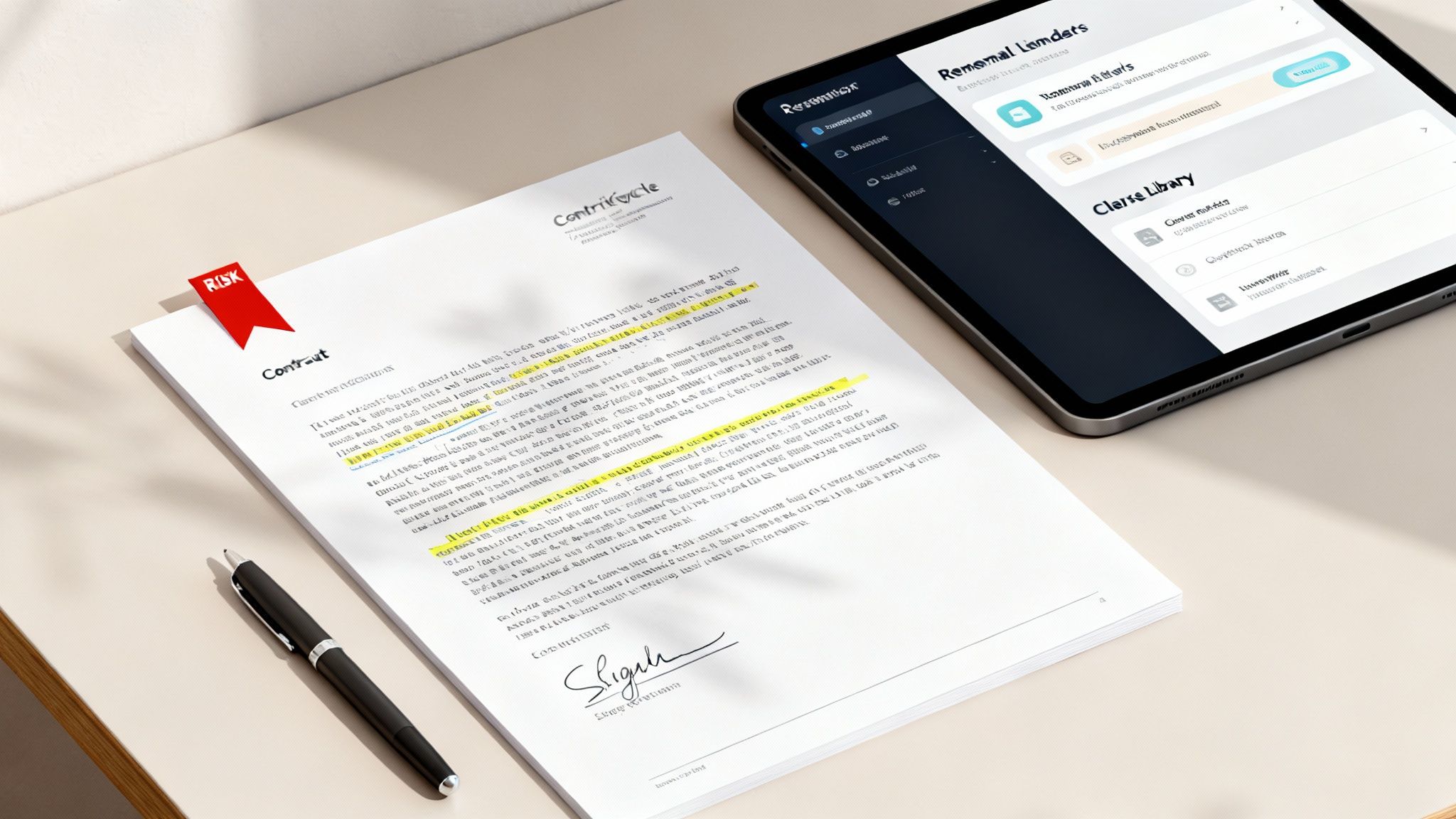In today's competitive landscape, manual processes are a significant bottleneck to growth. The difference between market leaders and their competitors often lies in their ability to automate, streamline, and scale operations efficiently. Business process automation (BPA) is no longer a luxury for large enterprises; it's a critical strategy for any company aiming to boost productivity, reduce errors, and free up its workforce for higher-value tasks.
But where do you start? The most effective way to grasp its potential is by examining tangible applications and real-world results. This article breaks down 10 powerful business process automation examples, moving beyond theory to provide a strategic blueprint you can follow. We will dissect the specific processes, detail the tools involved, and reveal the replicable strategies that drive meaningful change from finance and HR to customer service and operations.
For instance, sectors like finance have seen massive gains through automation. For a deeper understanding of how financial institutions are transforming their operations and enhancing customer experiences, explore the full scope of automation in banking. The principles demonstrated there, from loan origination to compliance reporting, offer valuable lessons for any service-based agency. Get ready to explore actionable insights you can implement immediately.
1. Invoice Processing and Accounts Payable Automation
Manual invoice processing is a notorious bottleneck, consuming countless hours and introducing significant potential for human error. One of the most impactful business process automation examples involves automating the entire accounts payable (AP) workflow. This process uses technologies like Optical Character Recognition (OCR) to scan and extract data from invoices, regardless of their format.
AI-powered systems then validate this information, match invoices to purchase orders, and route them for approval through a predefined digital workflow. This eliminates tedious data entry, accelerates payment cycles, and provides real-time visibility into financial liabilities.
Strategic Analysis & Actionable Tips
This automation is ideal for agencies and consulting firms managing a high volume of vendor or contractor invoices. For instance, Deloitte successfully leveraged this technology for Fortune 500 clients, achieving a 75% reduction in processing time. Similarly, Unilever cut its invoice processing staff by 60% after implementation, reallocating talent to more strategic financial analysis.
To successfully implement AP automation, follow these steps:
- Start Small: Begin with high-volume, standardized invoices from a few key vendors to refine the process before a full rollout.
- Define Exception Rules: Establish clear, automated procedures for handling exceptions like mismatched amounts or missing purchase order numbers.
- Train the AI: Utilize machine learning capabilities. Continuously feed corrected data back into the system to improve its accuracy over time.
For a deeper look into automating core business functions, you can explore top automation strategies for small businesses on timetackle.com.
2. HR Onboarding and Employee Lifecycle Management
Manual employee onboarding is often a fragmented and inefficient process, leading to a poor first impression and administrative headaches. Automating the HR onboarding and employee lifecycle is a powerful business process automation example that streamlines everything from offer letter generation to IT provisioning and eventual offboarding. This approach ensures every new hire receives a consistent, high-quality experience while improving compliance and reducing manual HR tasks.
Automated workflows trigger tasks sequentially across departments, such as creating user accounts, enrolling in benefits, and assigning mandatory training. This not only accelerates the process but also frees up HR professionals to focus on the human elements of integration, like culture and mentorship.
Strategic Analysis & Actionable Tips
This automation is critical for fast-growing agencies and consulting firms that need to onboard talent quickly and efficiently without sacrificing quality. For example, Google's automated onboarding process famously reduced first-day setup time for new engineers by 80%. Similarly, Accenture uses Workday automation to manage the entire lifecycle for its vast global workforce, ensuring consistency and compliance at scale.
To effectively implement HR automation, consider these steps:
- Map All Touchpoints: Before automating, thoroughly document every step and interaction in the current onboarding and offboarding processes.
- Create Role-Based Templates: Develop customized onboarding workflows for different roles (e.g., sales, engineering, design) to ensure new hires get relevant information and tools.
- Integrate Key Systems: Connect your HR platform with IT service management (ITSM) and learning management systems (LMS) for seamless provisioning and training.
For more insights into how automation can improve team well-being, you can discover how automating business processes contributes to a healthier work-life balance on timetackle.com.
3. Customer Onboarding and KYC (Know Your Customer)
Manual customer onboarding is often a slow, compliance-heavy process that creates friction for new clients and strains internal resources. A powerful business process automation example is the automation of Know Your Customer (KYC) and onboarding workflows, which is critical for regulated industries like finance and consulting. This involves using technology to handle identity verification, background checks, and compliance screening automatically.
Automated systems can scan and verify documents, cross-reference data against global watchlists, and approve low-risk customers in minutes. This not only dramatically reduces manual effort but also ensures a consistent, auditable, and compliant onboarding experience, minimizing both risk and customer drop-off.
Strategic Analysis & Actionable Tips
This automation is essential for financial services, consulting agencies, and any business handling sensitive client data that needs to balance a smooth customer experience with strict regulatory adherence. For instance, Revolut automates its onboarding to verify over 10,000 customers daily, while Wise (formerly TransferWise) reduced its KYC verification time to under one minute.
To successfully implement onboarding automation, follow these steps:
- Implement Tiered KYC: Design risk-based onboarding flows. Low-risk clients can be fast-tracked with minimal checks, while high-risk clients trigger more in-depth, automated verifications.
- Use Multi-Factor Verification: Integrate automated ID scanning, liveness detection, and biometric checks to significantly reduce the risk of fraud during the initial signup.
- Provide Clear Communication: Automate email and SMS notifications to guide users through the process, clearly stating what documents are needed and why.
For a deeper dive into optimizing client acquisition, you can learn how to speed up your sales cycle on timetackle.com.
4. Order Processing and Fulfillment Automation
The journey from a customer clicking "buy" to receiving their package is riddled with manual touchpoints that can cause delays and errors. One of the most critical business process automation examples for e-commerce and retail businesses is automating the end-to-end order fulfillment workflow. This involves connecting sales channels with inventory systems, warehouses, and shipping carriers to create a seamless, automated process.
Automation platforms receive order data, validate customer details, check inventory levels in real time, and automatically generate picking lists for warehouse staff. The system can then create shipping labels based on predefined rules, update the customer with tracking information, and adjust inventory counts across all sales channels. This dramatically reduces manual intervention, accelerates delivery times, and enhances customer satisfaction.
Strategic Analysis & Actionable Tips
This automation is essential for any business managing physical products, from e-commerce startups to large-scale distributors. For example, Shopify merchants leveraging built-in automation tools have seen order processing times reduced by over 50%. On a larger scale, Amazon's famed fulfillment centers use sophisticated robotics and automation to process hundreds of millions of orders with incredible speed and accuracy.
To effectively implement order fulfillment automation, consider these steps:
- Start with High-Volume SKUs: Focus your initial automation efforts on your best-selling products to maximize immediate impact and refine the workflow.
- Implement Real-Time Tracking: Integrate systems to provide customers and internal teams with live, transparent updates from order placement to final delivery.
- Establish Exception Protocols: Create automated alerts and workflows for handling exceptions like out-of-stock items or shipping address errors to prevent bottlenecks.
5. Claims Processing and Settlement
The manual processing of insurance, healthcare, or warranty claims is notoriously slow and prone to costly errors. A powerful business process automation example is the end-to-end automation of the claims lifecycle, from initial intake and validation to adjudication and final payment. This involves using intelligent automation to review documentation, verify policy details, and flag potential fraud.
Automated workflows accelerate resolution times, significantly reduce operational overhead, and ensure consistent application of business rules. This technology can automatically validate information against existing records, categorize claim types, and route complex cases to human adjusters, freeing up staff to handle high-value, nuanced decisions.
Strategic Analysis & Actionable Tips
This automation is critical for insurance carriers and healthcare providers managing immense claim volumes. For example, State Farm automated up to 70% of its insurance claims processing, while UnitedHealth Group cut its claim processing time by 60%. Similarly, global insurer AXA uses RPA to process over 10 million claims annually, enhancing both speed and accuracy.
To effectively implement claims automation, consider these steps:
- Implement Tiered Review: Configure the system to auto-approve low-risk, low-value claims that meet all predefined criteria, reserving manual review for high-risk or complex cases.
- Use AI for Fraud Detection: Leverage machine learning algorithms to analyze claim data and identify unusual patterns or anomalies that may indicate fraudulent activity.
- Create Feedback Loops: Establish a process for human adjusters to provide feedback on the system's decisions, continuously training the AI models to improve their accuracy and rule sets over time.
6. Contract Management and Lifecycle Automation
The lifecycle of a contract, from creation to renewal, is often a complex and disjointed process prone to delays and compliance risks. Automating contract management streamlines this entire workflow, using specialized software to generate, review, approve, execute, and monitor contracts. This is a powerful business process automation example that significantly reduces manual effort and enhances organizational compliance.
AI-driven platforms can automatically extract key terms, flag non-standard clauses, and manage critical deadlines like renewals or expirations. By centralizing all contractual information and automating alerts, businesses can mitigate risks, accelerate deal cycles, and gain complete visibility into their obligations.
Strategic Analysis & Actionable Tips
This automation is critical for any agency or consulting firm that handles a large volume of client, vendor, or partnership agreements. For example, Microsoft famously reduced its average contract approval time from two weeks to just two days. Similarly, a global brand like Coca-Cola uses automated workflows to effectively manage over 50,000 contracts, ensuring compliance and operational efficiency at scale.
To implement contract management automation successfully, consider these steps:
- Build Clause Libraries: Create a repository of pre-approved clauses to standardize and accelerate the contract creation process.
- Use AI for Risk Review: Leverage AI-powered tools to automatically scan documents and flag risky or non-standard terms for legal review.
- Automate Renewal Alerts: Configure automated alerts to notify stakeholders well in advance of contract expiration dates, preventing missed renewals or unwanted auto-renewals.
For an in-depth look at how automation can refine professional service operations, you can review key metrics for professional services automation on timetackle.com.
7. Expense and Reimbursement Automation
Manually processing employee expense reports is a drain on productivity for both employees and finance teams, leading to reimbursement delays and poor compliance. Another powerful entry in our list of business process automation examples tackles this by automating the entire expense management lifecycle. This involves using apps for receipt capture, AI for data extraction and categorization, and digital workflows for approval.
Automated systems instantly check submissions against company policies, flag out-of-policy spending, and route approved reports directly for reimbursement. This dramatically reduces the administrative burden, shortens payment cycles, and provides clear, real-time visibility into corporate spending.
Strategic Analysis & Actionable Tips
This automation is critical for consulting firms, agencies, and any business with a mobile workforce incurring frequent travel and client expenses. For example, platforms like SAP Concur process over 130 million expense reports annually, with some corporate spending solutions reducing reimbursement cycles by up to 80%. This frees up financial teams to focus on strategic analysis rather than manual verification.
To effectively implement expense automation, consider these steps:
- Integrate Corporate Cards: Connect company credit cards directly to the expense platform to automatically import transactions and simplify reconciliation.
- Establish Clear Policies: Program your specific spending rules, limits, and approval hierarchies directly into the system to enforce compliance automatically.
- Provide Manager Visibility: Ensure team leads and managers have real-time dashboards to monitor departmental spending and approve reports on the go.
8. Loan Origination and Approval Automation
The traditionally slow and paper-intensive process of loan origination is a prime candidate for automation. This business process automation example digitizes the entire lending lifecycle, from application intake and credit analysis to risk scoring and final approval decisions. Automated workflows handle income verification, collateral assessment, and compliance checks, dramatically accelerating lending cycles.
By leveraging AI and machine learning, systems can analyze vast datasets to produce more accurate risk assessments and deliver near-instant decisions. This not only enhances the customer experience but also allows financial institutions to maintain stringent risk management standards while scaling their operations efficiently.
Strategic Analysis & Actionable Tips
This automation is critical for financial institutions, from fintech startups to large banks, aiming to compete on speed and accuracy. For example, JPMorgan’s COIN platform automated loan origination tasks, reducing manual work by 360,000 hours annually. Similarly, SoFi has automated up to 80% of its loan approval decisions, enabling a faster, more streamlined experience for borrowers.
To effectively implement loan origination automation, consider these steps:
- Maintain an Audit Trail: Ensure the system automatically logs every decision and data point, creating a clear, comprehensive trail for regulatory compliance.
- Monitor for Algorithmic Bias: Regularly audit your AI models and algorithms to ensure fairness and prevent discriminatory outcomes in lending decisions.
- Establish Clear Escalation Paths: Define automated workflows for flagging and escalating exceptions or applications requiring manual review to the appropriate personnel.
9. Procurement and Purchase Order Automation
Manually managing procurement, from requisition requests to purchase order (PO) creation, is a resource-draining process rife with potential for unauthorized spending and operational delays. A powerful business process automation example is the end-to-end automation of the procurement workflow, which streamlines everything from initial request to final delivery receipt and payment. This system enforces compliance and provides a clear audit trail.
Automated procurement platforms create digital requisition forms, route them for approval based on predefined rules, automatically generate and send POs to selected vendors, and track order fulfillment. This integration provides complete visibility into the procure-to-pay cycle, significantly reducing maverick spending and optimizing supplier relationships.
Strategic Analysis & Actionable Tips
This automation is critical for companies managing complex supply chains or a large volume of purchase requests. For instance, Procter & Gamble successfully automated 80% of its purchase orders, freeing up its procurement team to focus on strategic sourcing. Similarly, Cisco leveraged automation to cut its procurement process time by 60%, enhancing operational agility.
To implement procurement automation effectively, follow these best practices:
- Establish Clear Policies: Define and digitize your procurement policies, including spending limits and approval hierarchies, before launching the system.
- Integrate with Inventory: Connect your procurement platform with inventory management systems to trigger automated reorders when stock levels fall below a certain threshold.
- Create Self-Service Portals: Empower employees with a user-friendly, self-service portal for submitting and tracking their own requisition requests, reducing the burden on procurement staff.
10. Regulatory Compliance and Report Generation
Navigating the complex landscape of regulatory compliance is a resource-intensive challenge for any business. Manual data gathering for regulations like GDPR, SOX, or CCPA is slow and prone to errors that carry severe financial and legal penalties. A powerful business process automation example is the automation of compliance monitoring and report generation. This involves deploying systems that automatically collect, validate, and compile data from various sources into audit-ready reports.
These platforms continuously scan systems for compliance deviations, ensuring that data handling policies are enforced around the clock. By automating data mapping, access logging, and evidence collection, companies can generate accurate compliance reports on demand, transforming a reactive, stressful process into a proactive and manageable one.
Strategic Analysis & Actionable Tips
This automation is critical for firms in highly regulated industries like finance, healthcare, and technology, where non-compliance can be catastrophic. For instance, major consulting firms like KPMG and Deloitte have successfully implemented automated compliance frameworks for financial institutions, ensuring adherence to strict anti-money laundering (AML) and SOX requirements. This not only reduces risk but also significantly lowers the cost of manual audits.
To effectively automate your compliance processes, follow these key steps:
- Implement Continuous Monitoring: Deploy tools that continuously scan your systems for policy violations or suspicious activities, rather than relying on periodic manual checks.
- Create Automated Alerts: Set up automated alert systems to notify key personnel of potential compliance breaches or upcoming reporting deadlines in real time.
- Maintain Centralized Documentation: Use an automated system to manage and update all compliance policies and procedures, ensuring a single source of truth for audits.
Top 10 Business Process Automation Use Case Comparison
| Automation Area | 🔄 Implementation Complexity | ⚡ Resource Requirements | 📊 Expected Outcomes | 💡 Ideal Use Cases | ⭐ Key Advantages |
|---|---|---|---|---|---|
| Invoice Processing and Accounts Payable Automation | Medium–High — integration & data cleanup | OCR, AI/ML models, ERP connectors, vendor onboarding | Processing time days→hours; cost ↓60–80%; fewer posting errors | High-volume vendor invoicing; multi-currency finance teams | Cost savings; improved cash visibility; faster vendor payments |
| HR Onboarding and Employee Lifecycle Management | Medium — multi-system integration, change mgmt | HRIS, e-signature, IT provisioning tools, LMS integration | Onboarding weeks→days; better compliance & data quality | Large hiring volumes; distributed/remote workforces | Consistent experience; reduced IT/setup errors; frees HR time |
| Customer Onboarding and KYC | High — regulatory & identity tech complexity | ID verification, AML databases, secure storage, risk engines | Onboarding minutes vs days; improved compliance; higher conversion | Banks, fintechs, regulated customer acquisition flows | Faster acquisition; scalable compliance; stronger fraud detection |
| Order Processing and Fulfillment Automation | High — WMS, robotics, warehouse redesign | WMS, RPA/robotics, inventory systems, shipping integrations | Order processing ↓40–60%; fewer pick/pack errors; faster delivery | E‑commerce, high-volume fulfillment centers | Faster fulfillment; lower labor costs; better inventory accuracy |
| Claims Processing and Settlement | Medium–High — complex rule sets, sensitive data | Document capture, ML fraud models, adjudication engines | Claims 3–5x faster; costs ↓40–50%; improved consistency | Insurance, healthcare reimbursements, warranty claims | Faster settlements; improved fraud prevention; scalable peak handling |
| Contract Management and Lifecycle Automation | Medium — legal setup and template creation | CLM platform, clause library, AI term extraction, e‑sign | Contract cycle time ↓50–70%; improved compliance & visibility | Legal teams, procurement, sales with high contract volume | Reduced legal risk; faster approvals; centralized obligations tracking |
| Expense and Reimbursement Automation | Low–Medium — mobile adoption & policy setup | Mobile OCR, policy engine, card integrations, finance ERP | Reimburse time weeks→days; admin workload ↓60–70%; better compliance | Organizations with distributed employees and frequent expenses | Faster reimbursements; improved policy compliance; fraud detection |
| Loan Origination and Approval Automation | High — regulatory, bias monitoring, data sources | Credit bureaus, risk models, verification APIs, audit trails | Approvals weeks→hours; costs ↓40–50%; better risk consistency | Banks, fintech lenders scaling application volume | Faster lending decisions; improved risk scoring; operational savings |
| Procurement and Purchase Order Automation | Medium–High — supplier integrations & data hygiene | E‑procurement platform, S2P tools, supplier master data | Cycle time ↓50–70%; reduced maverick spend; better spend analytics | Large enterprises with many suppliers and recurring POs | Cost savings; spend visibility; supplier compliance |
| Regulatory Compliance and Report Generation | High — legal interpretation & frequent changes | Data connectors, policy engines, audit trail, reporting templates | Report generation ↓80%; lower violation risk; faster audits | Highly regulated industries (finance, healthcare, payments) | Continuous compliance; faster audit prep; consistent evidence collection |
From Insight to Action: Implementing Your Automation Strategy
The business process automation examples we've explored, from streamlining accounts payable to accelerating HR onboarding, reveal a powerful, unifying theme. True transformation isn't born from simply plugging in new software; it's the result of a deliberate, strategic shift in how your organization approaches its core operations. The most successful implementations begin not with a tool, but with a deep understanding of existing workflows and their inherent friction points.
These examples consistently demonstrate that the path to effective automation is incremental. It starts by identifying the high-volume, low-value tasks that drain your team's energy and create operational bottlenecks. By focusing on these areas first, you can secure quick wins that build momentum, prove ROI, and foster a culture that embraces, rather than resists, technological change.
From Identification to Implementation: Your Action Plan
Transitioning from theory to practice requires a clear roadmap. The recurring pattern across all successful business process automation examples involves a phased, data-informed approach. You don't need to overhaul your entire company overnight.
Here is a replicable, three-step framework to begin your journey:
-
Audit and Identify: Start by mapping your most critical business processes. Where are the delays? What tasks are repetitive, manual, and prone to human error? Focus on processes like expense reporting, invoice processing, or even the time-consuming ordeal of manual timesheet creation and reconciliation.
-
Pilot and Prove: Select one or two of these identified pain points for a pilot project. Choose a process where the impact of automation will be easily measurable, such as reducing invoice processing time or improving the accuracy of compliance reports. This creates a compelling internal case study for broader adoption.
-
Analyze and Scale: Once your pilot is successful, the key is to scale intelligently. This is where a data-driven understanding of how your team's time is actually spent becomes invaluable. Without it, you're merely guessing at the next best opportunity for automation.
Strategic Insight: The most significant barrier to effective automation isn't technology; it's a lack of visibility into where your team's most valuable resource-time-is being allocated. Guesswork leads to automating the wrong processes and a disappointing return on investment.
This is precisely why understanding resource allocation is the bedrock of a scalable automation strategy. By analyzing how hours are distributed across clients, projects, and internal tasks, you can pinpoint the exact workflows that are prime candidates for automation. This ensures your efforts are always directed at the areas of greatest impact, maximizing efficiency gains and directly contributing to your bottom line. The journey from manual inefficiency to automated excellence is paved with data, turning abstract business process automation examples into a tangible, profitable reality for your agency or firm.
Ready to uncover the hidden inefficiencies in your workflows? The first step to powerful automation is understanding where your time goes. TimeTackle provides AI-powered calendar analytics and effortless time tracking to give you the data-driven insights needed to identify your best automation opportunities. Start your free trial of TimeTackle today and turn operational insight into impactful action.






